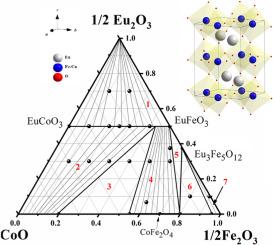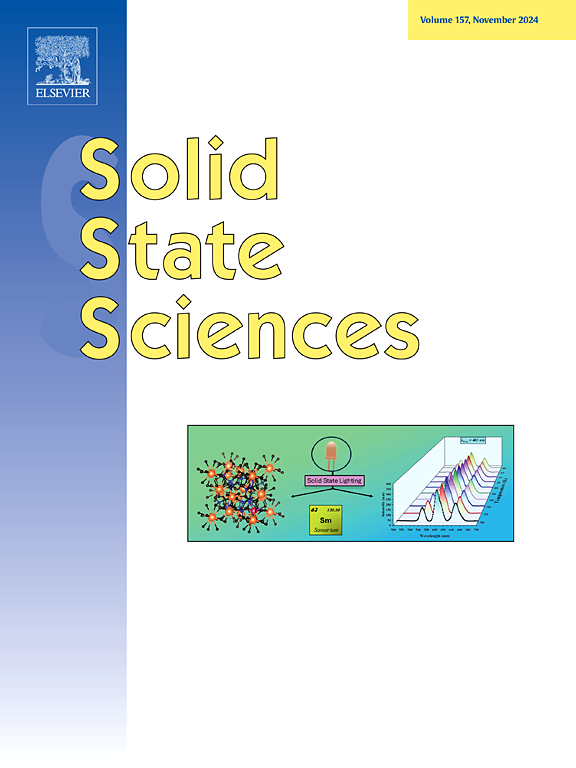Phase equilibria and properties of complex oxides in the ½ Eu2O3 – ½ Fe2O3 – CoO system
IF 3.3
3区 化学
Q2 CHEMISTRY, INORGANIC & NUCLEAR
引用次数: 0
Abstract
Phase equilibria in the ½ Eu2O3 – ½ Fe2O3 – CoO system are studied at 1100 °C in air. A continuous series of EuFe1-xCoxO3-δ solid solutions between europium ferrite and europium cobaltite with an orthorhombically distorted perovskite structure (SG Pbnm) has been confirmed. The unit cell parameters and unit cell volume of EuFe1-xCoxO3-δ solid solutions obey Vegard's law. The homogeneity ranges of solid solutions in quasi-binary ½ Fe2O3 – CoO constituent subsystems at 1100 °C in air, taken from various works, are analyzed, and a phase diagram for the ½ Eu2O3 – ½ Fe2O3 – CoO system, consisting of 4 two-phase and 3 three-phase fields is constructed. The oxygen content in EuFe1-xCoxO3-δ solid solutions is determined by the hydrogen reduction and iodometric titration methods. Oxygen losses with increasing temperature are small, maximum oxygen deficiency δ at 1000°C does not exceed 0.05. Linear thermal expansion of EuFe1-xCoxO3-δ ceramics was measured by dilatometry. The nonlinear behavior of the dilatometric curves is discussed in terms of a possible change in the spin state of Co3+ ions. Electrical conductivity, which is low at room temperature and does not differ for all the samples studied, increases significantly with increasing temperature and Co content.

1 / 2 Eu2O3 - 1 / 2 Fe2O3 - CoO体系中复合氧化物的相平衡和性质
在1100℃的空气中研究了1 / 2 Eu2O3 - 1 / 2 Fe2O3 - CoO体系的相平衡。EuFe1-xCoxO3-δ固溶体在铁酸铕和钴酸铕之间形成了具有正交扭曲钙钛矿结构(SG pnm)的连续系列固溶体。EuFe1-xCoxO3-δ固溶体的单元胞参数和单元胞体积服从Vegard定律。本文分析了在1100℃空气中准二元½Fe2O3 - CoO组成子系统中固溶体的均匀性范围,并构建了½Eu2O3 -½Fe2O3 - CoO体系由4个两相场和3个三相场组成的相图。采用氢还原法和碘滴定法测定了EuFe1-xCoxO3-δ固溶体中的氧含量。氧损失随温度升高而减小,在1000℃时最大缺氧δ不超过0.05。用膨胀法测定了EuFe1-xCoxO3-δ陶瓷的线性热膨胀。根据Co3+离子自旋态可能发生的变化,讨论了膨胀曲线的非线性行为。电导率在室温下较低,在所研究的所有样品中没有差异,随着温度和Co含量的增加而显着增加。
本文章由计算机程序翻译,如有差异,请以英文原文为准。
求助全文
约1分钟内获得全文
求助全文
来源期刊

Solid State Sciences
化学-无机化学与核化学
CiteScore
6.60
自引率
2.90%
发文量
214
审稿时长
27 days
期刊介绍:
Solid State Sciences is the journal for researchers from the broad solid state chemistry and physics community. It publishes key articles on all aspects of solid state synthesis, structure-property relationships, theory and functionalities, in relation with experiments.
Key topics for stand-alone papers and special issues:
-Novel ways of synthesis, inorganic functional materials, including porous and glassy materials, hybrid organic-inorganic compounds and nanomaterials
-Physical properties, emphasizing but not limited to the electrical, magnetical and optical features
-Materials related to information technology and energy and environmental sciences.
The journal publishes feature articles from experts in the field upon invitation.
Solid State Sciences - your gateway to energy-related materials.
 求助内容:
求助内容: 应助结果提醒方式:
应助结果提醒方式:


